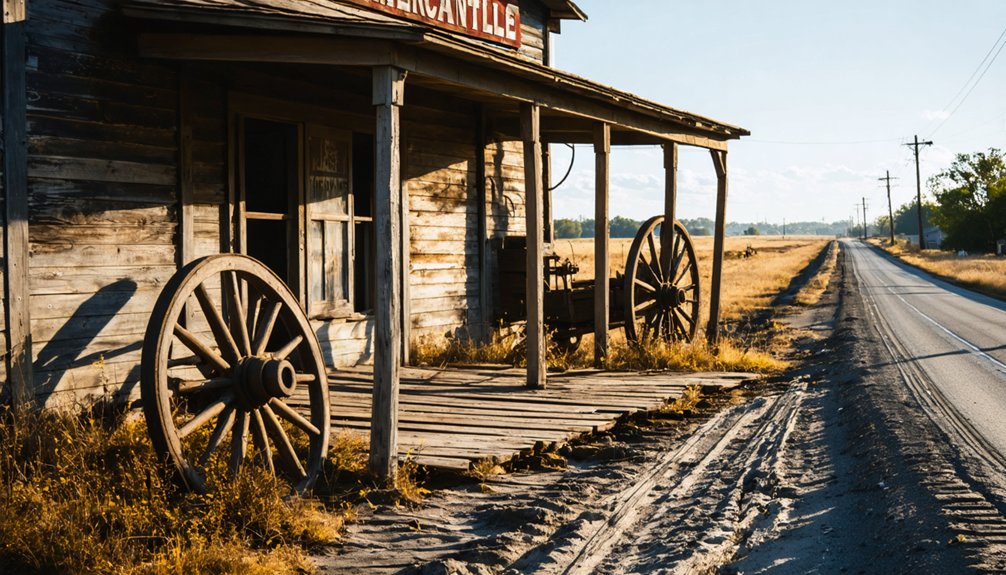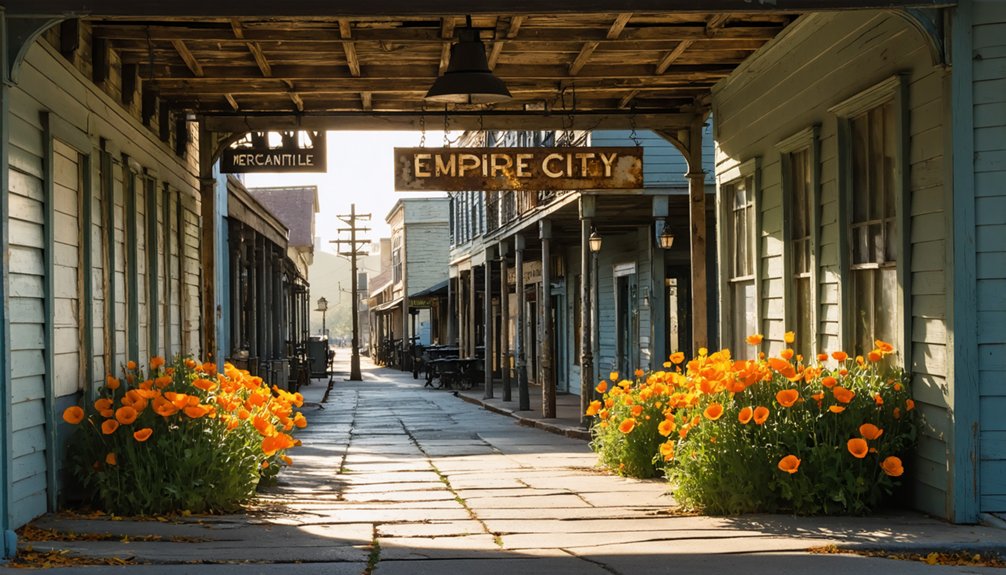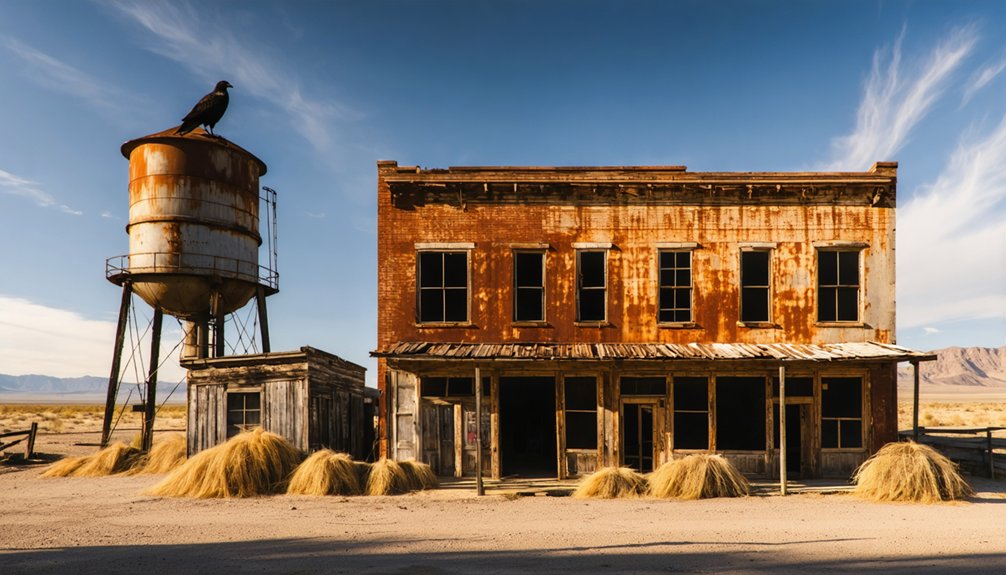Empire City, California was a short-lived settlement founded in 1850 by John G. Marvin that briefly served as Stanislaus County’s seat (1854-1855). You’ll find it completely vanished after the catastrophic Great Flood of 1861-1862, which transformed California’s Central Valley into an inland sea. Today, only Empire Cemetery and Historical Marker #418 at Empire Community Park preserve its memory. The flood’s destructive power reveals a fascinating chapter of California’s forgotten pioneer history.
Key Takeaways
- Empire City, established in 1850, was completely erased from maps after the devastating Great Flood of 1861-1862.
- The ghost town briefly served as Stanislaus County’s second seat from 1854-1855 before its eventual demise.
- Empire Cemetery remains the only physical remnant, containing approximately 200 pioneer graves on elevated ground.
- Historical Marker #418, established in 1961, commemorates the town’s significance near the original site.
- Empire City’s strategic location made it an important military supply hub via steamboats on the Tuolumne River.
The Founding of Empire City (1850)
The establishment of Empire City in 1850 marked a strategic settlement on the south bank of the Tuolumne River in what would become Stanislaus County.
Boston lawyer John G. Marvin (though some records cite John C. Marvin) selected this location for its river navigation potential, creating a crucial lifeline for Early Settlers amid the California Gold Rush economy.
You’ll find the town’s ambitious name reflected its founders’ aspirations, reportedly inspired by New York City’s “Empire City” nickname.
The founders envisioned creating a regional power center with central control over surrounding territories and trade routes.
This promising settlement soon achieved significant status as the second county seat of Stanislaus County before its ultimate demise.
Despite Founding Challenges, the settlement quickly gained importance as a steamboat navigation hub and military supply depot for Forts Miller and Tahone.
Life Along the Tuolumne River
Flowing steadily from its Sierra Nevada origins through varied ecosystems, the Tuolumne River has historically sustained a remarkably rich riparian environment where native flora and diverse wildlife flourished alongside human settlements.
If you’d visited Empire City in its heyday, you’d have witnessed the river’s dual role in shaping both natural landscapes and human enterprise. The Miwok and Yokuts peoples built their cultural heritage around these waters long before miners arrived seeking fortune.
You’d find river ecosystems teeming with turtles, otters, and dozens of bird species amid tule reeds and seasonal floodplains. Later, water development transformed the river’s purpose—first serving miners through elaborate ditch systems, then feeding agricultural demands via reservoirs like Don Pedro. Extensive water system networks developed in the 1850s and 1860s were crucial for supporting gold mining operations throughout the region. Today, the river stretches approximately 149 miles from the mountains to its confluence with the San Joaquin River.
The river’s seasonal rhythms dictated life’s pace, creating a freedom that modern water control has fundamentally altered.
Empire City as Stanislaus County Seat
Three critical factors defined Empire City‘s brief tenure as Stanislaus County‘s second seat of government from October 1854 to December 1855.
The Marvin brothers orchestrated this political victory despite initially losing to Adamsville by promising $10,000 for a county building—a commitment they never fulfilled.
County seat significance became apparent through:
- The political maneuvering that secured Empire City’s status through financial promises rather than voter preference
- The inadequate infrastructure that forced supervisors to conduct business in barns, damaging governmental dignity
- The environmental vulnerability that eventually contributed to the settlement’s downfall
Empire City’s fate was sealed when devastating floods destroyed many of its buildings, making it unsuitable for governmental operations.
This pattern of instability reflects how territorial empires often require contiguous land control to maintain political dominance over peripheral regions.
Empire City’s legacy as county seat lasted merely 14 months before restless citizens demanded relocation, marking one chapter in the young county’s search for a permanent governmental home.
Military Supply Hub for California Forts
Empire City’s strategic position at the head of navigation on the Tuolumne River established it as a crucial military supply hub for California installations, particularly Forts Miller and Tahone.
You’ll find that steamboats regularly departed from Empire City’s docks, transporting essential provisions, ammunition, and equipment upstream to support troop operations and territorial defense.
The town’s military significance was bolstered by purpose-built infrastructure including warehouses, loading facilities, and service establishments that coordinated the complex logistics of frontier defense during California’s tumultuous early statehood. Prior to being destroyed in the Great Flood of 1862, Empire City served as a critical link between coastal military depots and inland defensive positions.
The settlement was officially established in 1850 by John G. Marvin, who recognized the location’s potential as a transportation and supply nexus for the growing California territory.
Strategic Riverfront Location
The strategic position along the Tuolumne River’s south bank transformed Empire City into a vital military supply hub during California’s territorial expansion.
As the furthest navigable point on the river, this settlement commanded essential river trade routes while facilitating military operations throughout the region.
You’ll appreciate why this location proved invaluable to frontier development:
- Small steamboats could reach Empire City directly, establishing efficient transportation routes between coastal areas and inland settlements.
- The riverfront enabled rapid distribution of supplies to Forts Miller and Tahone.
- Agricultural products from surrounding areas were efficiently shipped downstream, boosting regional commerce.
This prime location fueled Empire City’s rapid growth in the 1850s, creating a nexus for both military logistics and commercial trade that shaped early California’s development patterns. During its brief tenure as county seat from 1854-1855, Empire City further solidified its regional importance. Empire City’s strategic importance ended when the settlement was completely destroyed by flood between 1861 and 1862.
Fort Supply Operations
While many frontier settlements flourished through commercial trade alone, Empire City distinguished itself through Fort Supply‘s critical military operations during the Mexican-American War era. This installation, initially named Fort Mervine after Captain William Mervine, served as the linchpin connecting naval support with inland fortifications.
You’ll appreciate how Fort Supply managed complex military logistics under Battery F, Third Artillery, who replaced Marines as garrison forces. The fort coordinated munitions, food, and medical supplies between Navy ships and interior posts despite significant supply challenges.
Officers like Lieutenant Edward Ord and William Tecumseh Sherman oversaw these operations before achieving Civil War fame. This strategic hub enabled rapid response to regional threats by maintaining forward stockpiles, though operations ended abruptly when gold fever struck and troops disbanded for the goldfields.
Military Transport Coordination
Strategically positioned at the Tuolumne River’s navigational head, Empire City evolved into a pivotal military supply hub that orchestrated the complex logistics network supporting California’s frontier forts.
The town’s infrastructure enabled seamless shifts between river transport and overland routes, ensuring critical military provisions reached Fort Miller and Fort Tahone efficiently.
When you examine Empire City’s military logistics system, you’ll find:
- Small steamboats maneuvering the Tuolumne delivered bulk supplies to the town’s specialized docks
- Warehouses designed specifically for military cargo facilitated rapid inventory management
- Coordinated overland transport networks connected Empire City to remote outposts
This strategic position allowed Empire City to respond to both routine resupply missions and emergency operations, greatly enhancing the territorial security of California during its formative frontier period.
The Great Flood of 1861-1862
You’d scarcely recognize California after the Great Flood of 1861-1862, when 43 days of relentless rainfall transformed the Central Valley into a 300-mile inland sea and claimed an estimated 4,000 lives.
Empire City, once a bustling military supply hub, met its demise as the swollen river obliterated buildings, infrastructure, and livelihoods—the floodwaters showing no mercy to the vulnerable settlement.
Unlike larger towns that rebuilt, Empire City vanished completely from maps, its foundations washed away and its existence relegated to historical footnotes as one of several communities permanently erased by the catastrophic deluge.
Devastating Regional Impact
When the Great Flood of 1861-1862 struck California, it released destruction of unprecedented magnitude, transforming the state’s landscape and economy almost beyond recognition. The Central Valley became an inland sea stretching 300 miles, while Sacramento remained submerged for months, forcing residents to navigate by boat and relocating the state government to San Francisco.
The catastrophic impact crippled California’s financial stability:
- Economic damages reached $100 million (equivalent to $3 billion today)
- The state couldn’t pay workers for 18 months
- Approximately 25% of California’s economic output was destroyed
This disaster forever altered California’s approach to flood recovery and urban planning.
Sacramento’s subsequent 20-year elevation project and Victorian architecture with raised porches remain evidence of the lessons learned—adaptations born from necessity when nature overwhelmed humanity’s assumptions about controlling the landscape.
River’s Fatal Vengeance
The catastrophe that transformed California’s landscape began innocuously on Christmas Eve 1861, releasing a 43-day atmospheric assault that would rewrite the state’s history.
You’d hardly recognize the California that emerged in the flooding aftermath—a state bankrupted, with one-quarter of its real estate obliterated and nearly 4,000 souls lost.
The river’s legacy proved merciless. Sacramento vanished under ten feet of water while Southern California’s major waterways merged into an 18-mile-wide inland sea.
Communication collapsed as telegraph lines failed and bridges washed away. Even government itself surrendered, relocating from the capital to San Francisco.
For indigenous peoples like the Paiute, starvation followed as game animals perished.
The Central Valley, once fertile, now lay reshaped—its topsoil carried away by waters that had carved new channels through the land.
Town Permanently Erased
Among California’s countless casualties in the Great Flood of 1861-1862, Empire City stands as perhaps the most complete erasure from the historical record.
Unlike Sacramento, which rebuilt after being submerged under 10 feet of water, Empire City’s town history ended abruptly when floodwaters physically obliterated every structure.
The flood aftermath was absolute:
- The town vanished entirely from maps and records following 43 consecutive days of relentless precipitation.
- No recovery efforts were mounted, unlike in larger settlements.
- Empire City joined Mokelumne City as settlements completely destroyed by the inland sea that formed across 3.5 million acres.
You’re witnessing, through historical accounts, the rare case of a community not merely damaged but completely erased—representing the catastrophic power that transformed California’s landscape and economy for decades.
Empire Cemetery: Final Resting Place on the Hill
Perched prominently on elevated terrain near the Tuolumne River, Empire Cemetery stands as both sentinel and chronicler of Stanislaus County’s pioneer history.
When you visit this California Historic Landmark, you’ll find approximately 200 souls—laborers, merchants, and farmers who shaped Empire City before the devastating 1862 flood.
The cemetery’s strategic hilltop location saved these pioneer memories from watery destruction, preserving the legacy of those who built Stanislaus County’s original seat.
Today, cemetery preservation efforts maintain this sacred ground where historical markers erected by organizations like E Clampus Vitus document the site’s significance.
Adjacent to Empire Community Park, this final resting place continues to honor the diverse Gold Rush population whose determination and sacrifice helped forge California’s early development.
Transportation and Commerce in Gold Rush California

While Empire City’s cemetery honors those who arrived seeking opportunity in California’s fledgling communities, understanding how they reached these remote settlements reveals a remarkable story of human determination.
Transportation challenges shaped every aspect of Gold Rush migration, with pioneers facing harrowing journeys:
- Overland wagon trains required 4-6 months of treacherous travel across mountains and deserts, with custom rigging solutions becoming crucial for survival.
- Sea routes around Cape Horn or through Panama presented deadly risks but became essential economic lifelines.
- Improvised infrastructure like suspension bridges connected isolated mining regions, enabling commerce evolution.
You’d likely be surprised to learn the real economic winners weren’t miners but the entrepreneurs who supplied them.
Transportation innovations and commercial services—banking, real estate, and retail—created California’s lasting wealth, while most gold seekers struggled to profit from their arduous journeys.
What Remains Today: Historical Marker #418
You’ll find California Historical Landmark #418 at Empire Community Park, where it commemorates the once-thriving Empire City that served as Stanislaus County’s second county seat from 1854 to 1855.
The marker, erected in 1961 by E Clampus Vitus, stands as the primary physical reminder of this former settlement that was destroyed in the Great Flood of 1861-62.
Originally placed on Santa Fe Avenue, the monument was relocated to the park for improved public access, allowing visitors to connect with this important piece of Gold Rush-era California history.
Marker’s Historical Significance
Today, historical marker #418 stands as the primary physical reminder of Empire City’s existence, commemorating what was once a thriving river port and brief county seat. Dedicated in 1961 by the Estanislao Chapter of E Clampus Vitus, this monument preserves the pioneer legacy of a settlement that vanished after the Great Flood of 1862.
The marker’s significance extends beyond mere commemoration:
- It documents Empire City’s role as Stanislaus County’s second courthouse location from 1854-1855.
- It establishes the town’s importance as the head of Tuolumne River navigation.
- It anchors historical narratives about regional development during California’s formative years.
You’ll find the marker relocated to Empire Community Park, about a mile north of the original townsite—a bronze symbol of ambitious settlers whose riverside community once shaped the region’s economic and civic landscape.
Location and Access
The precise location of Empire City’s historical marker #418 provides the only tangible link to this vanished settlement’s past. You’ll find it at Empire Community Park‘s eastern parking area, approximately one mile north of the original town site. The marker’s accessibility makes it ideal for history enthusiasts seeking connection to this pioneer settlement that once served as Stanislaus County’s second seat.
To reach this piece of historical preservation, turn south onto First Street from Yosemite Boulevard (CA-132).
The original town site, however, lies about a mile south across agricultural land with no visible structures remaining. This unmarked location along the Tuolumne River’s south bank—once bustling with steamboats and military supply operations—now exists only in memory and the carefully placed marker that commemorates its brief but significant existence.
Empire City vs. Nevada’s Ghost Town Namesake

Although sharing the same name, California’s Empire City and Nevada’s Empire City represent two distinct chapters in Western American history.
Two namesake frontiers, Empire City—one in California, another in Nevada—tell separate tales of America’s westward journey.
California’s ghost town originated in 1850 as Stanislaus County’s seat along the Tuolumne River, while Nevada’s counterpart emerged a decade later during the Comstock Lode silver rush.
The differences between these frontier settlements become clear when you examine:
- Function: California’s site served governmental and navigation purposes; Nevada’s operated as an industrial hub for mining and lumber.
- Timeframe: California’s Empire preceded Nevada’s by approximately ten years.
- Fate: California’s Empire was destroyed by floods in 1861-62; Nevada’s declined with mining operations.
Today, both sites exist only as historical markers and ghost town remnants, preserving different aspects of America’s pioneering spirit and westward expansion.
Preserving the Memory of Pioneer Settlers
Since the devastating floods of 1861-1862 erased much of Empire City’s physical presence, dedicated preservation efforts have become essential to maintaining this pioneer settlement’s historical significance.
You’ll find Empire City’s pioneer heritage commemorated through California Historical Landmark No. 418, established by E Clampus Vitus in 1961. This marker honors the town’s brief tenure as Stanislaus County’s second seat and acknowledges the men and women who settled this frontier outpost.
The Empire Cemetery stands on elevated ground—a deliberate choice by settlers to protect their deceased from flooding—providing a tangible connection to these early Californians.
While physical structures have disappeared, historical documentation, archival preservation, and educational initiatives sustain Empire City’s legacy. These efforts have integrated the settlement into regional ghost town tourism, allowing you to experience this vanished chapter of California’s pioneering past.
Frequently Asked Questions
Were Any Famous Historical Figures Associated With Empire City?
You’ll find two notable historical figures associated with Empire City: John G. Marvin, the town’s founder, and Solomon Wagenheim, who orchestrated the largest lumber drive—both pivotal in famous historical events.
What Was the Population of Empire City Before the Flood?
You won’t find exact population demographics for Empire City before the flood. Historical significance notwithstanding, records suggest it was a small settlement, likely numbering only in the low hundreds of inhabitants.
Did Any Businesses or Industries Survive the Relocation?
No, you won’t find any surviving businesses from Empire City after the relocation impact. The economic discontinuity was complete—new ventures in the new Empire replaced, rather than continued, the original town’s enterprises.
What Indigenous Tribes Occupied the Area Before Empire City?
You’d discover that the Yokuts peoples, primarily Northern Valley bands, occupied the area before Empire City. The Miwok tribes from nearby foothills also frequented this indigenous history-rich Tuolumne River corridor of tribal significance.
Are There Documented Paranormal Experiences at the Empire Cemetery?
You won’t find documented ghost sightings or cemetery legends at Empire Cemetery. Research reveals no verified paranormal experiences in historical records, though similar ghost towns often generate such accounts elsewhere.
References
- https://ziggyspeaks.wordpress.com/2016/09/09/empire-city-a-nevada-ghost-town/
- https://www.visitcalifornia.com/road-trips/ghost-towns/
- https://en.wikipedia.org/wiki/List_of_ghost_towns_in_California
- https://noehill.com/stanislaus/cal0418.asp
- https://www.hmdb.org/m.asp?m=20210
- https://ohp.parks.ca.gov/ListedResources/Detail/418
- https://nvtami.com/2020/06/19/empire-city-nevada/
- https://kids.kiddle.co/Empire
- https://en.wikipedia.org/wiki/Empire
- https://landmarkquest.com/omeka/items/show/983



